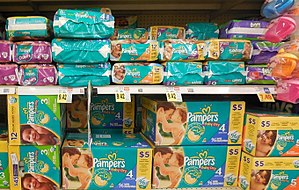Diapers

A diaperW (in North America) or nappy (in the United Kingdom, many Commonwealth countries and Ireland) is an absorbent garment worn by individuals (usually babies) who are incapable of controlling their bladder or bowel movements, or are unable or unwilling to use a toilet. The purpose of a diaper is to absorb moisture and contain mess so that the wearer can remain dry and comfortable after wetting or soiling themselves. When diapers become full and can no longer hold any more waste, they require changing; this process is often performed by a secondary person such as a parent or caregiver. Failure to change a diaper on a regular enough basis can result in diaper rash.
There has been a considerable debate among parents concerning the environmental impact of cloth vs disposable diapers..[1] Overall as one can see below the semiquantitative answer between those two choices for the environment is cloth.,[2][3] However, now there are several other options available to parents wanting to live a green lifestyle.
Disposal Diapers[edit | edit source]
The most obvious negative environmental impactW of disposable diapers lies in the fact that they are thrown away and normally landfilled.The average baby goes through 5,000 diapers before being potty-trained. Because 95% of these diaper changes are disposable diapers, most of them end up in landfillsW.[4] Diapers made up 3.4 million tons of waste, or 2.1% of U.S. garbage, in landfills in 1998 -- the last year this information was collected, according to the Environmental Protection AgencyW. Diapers in landfills in underdeveloped countries are especially problematic because they often aren't properly disposed, and excrement leaks into the local waterW supply.[5] Disposable diapers produce at least 70 times more municipal solid waste–trash–than do cloth diapers.[6]
The other two major environmental costs associated with disposables lies in their production. About 70% of the diaper is made of wood fiber from trees, which although they are a renewable resource in theory - sustainable forestryW is far from the norm in practice. Standard tree production requires some plant nutrients, pesticidesW, mechanical energyW, waterW, and other inputs. For mono-cropped tree farmsW the planting of a single species It reduces species diversityW in the area of production. The entire life cycleW of the diaper involves use of energyW, embodied energy of transportation, chemicals, waterW in the manufacturing, distribution, and disposal of the diapers. These environmental costs can be reduced by using recycled paperW fiber, though this is not done to any major extent today..[7] The remaining 30% of the disposable diaper comes from petroleumW, a nonrenewable resource.
Overall, it is estimated that roughly 5 million tons of untreated waste and a total of 2 billion tons of urine, feces, plastic and paper are added to landfills annually with disposable diapers -- to make them it takes around 80,000 pounds of plasticW and over 200,000 treesW a year to manufacture the disposable diapers for American babies alone.[8]
Cloth Diapers[edit | edit source]
Cloth diapers are reusable and can be made from natural fibers, manmade materials, or a combination of both. They are often made from industrial cotton which may be bleached white or left the fiber's natural color. Other natural fiber cloth materials include wool, bambooW, and unbleached hemp. For washing cloth diapers see information for Washing and drying clothesW.
The major environmental impact of cloth diapers is due to the laundering. In the worst case scenario, a load of home-laundered diapers uses up to 50 gallons of waterW. New Energy starW clothes washers use considerably less, as does washing by hand. The water to wash the diapers must also be heated, normally with natural gasW, fuel oilW, or electricityW. All of these methods have an environmental impact. Again using a solar hot waterW heater reduces this environmental cost. There is also a negative environmental impact associated with chemical detergents and bleach. The same impact is also created using a laundromat or through a diaper service although then there is an additional cost due to the embodied energy of transportationW.
As with all products - the product life cycle (production, distribution, use, and disposal) of cloth diapers also have environmental impacts. These costs are primarily due to cotton, which if not grown using organic agricultureW has pesticidesW, herbicidesW, fertilizerW, waterW, and mechanical energyW. Again standard agricultural practices tend to increase soil erosionW and species diversityW.
No Diapers and "Elimination Communication"[edit | edit source]
Train your child to not need diapers. This sounds a bit crazy at first to the typical American- but there are lots of people supporting diaper free methods.[9] "Elimination Communication" can have an environmental benefits of common developing world practice. Elimination communicationW is a process by which a caregiver uses timing, signals, cues, and intuition to address an infant's excretion needs, partially or completely avoiding the use of diapers.